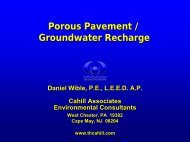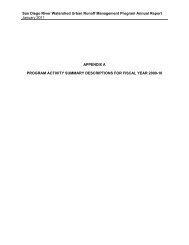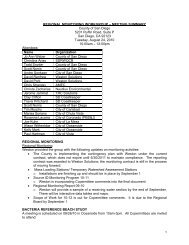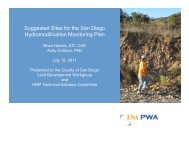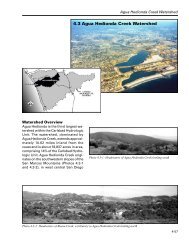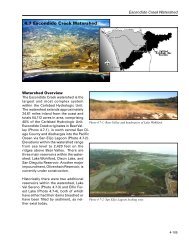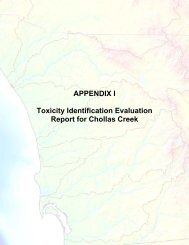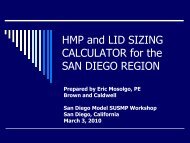APPENDIX I Toxicity Identification Evaluation Reports for Chollas ...
APPENDIX I Toxicity Identification Evaluation Reports for Chollas ...
APPENDIX I Toxicity Identification Evaluation Reports for Chollas ...
You also want an ePaper? Increase the reach of your titles
YUMPU automatically turns print PDFs into web optimized ePapers that Google loves.
<strong>Toxicity</strong> <strong>Identification</strong> <strong>Evaluation</strong> of Sweetwater<br />
River Stormwater Using Selenastrum<br />
capricornutum August 2006<br />
6. REFERENCES<br />
Cali<strong>for</strong>nia Regional Water Quality Control Board (RWQCB). 1994. Water Quality Control Plan<br />
<strong>for</strong> the San Diego Basin. September.<br />
Kaiser Engineers. 1969. Final Report to the State of Cali<strong>for</strong>nia, San Francisco Bay-Delta Water<br />
Quality Control Program, State of Cali<strong>for</strong>nia, Sacramento, CA.<br />
LeBlond, J.B., and Duffy, L.K. 2001. <strong>Toxicity</strong> assessment of total dissolved solids in effluent of<br />
Alaskan mines using 22-h chronic Microtox® and Selenastrum capricornutum assays. The<br />
Science of the Total Environment, 271:49-59.<br />
Mount, D.R., Gulley, D.D., Hockett, J.R., Garrison, T.D., and Evans, J.M. 1997. Statistical<br />
models to predict the toxicity of major ions to Ceriodaphnia dubia, Daphnia magna and<br />
Pimephales promelas (fathead minnows). Environmental Toxicology and Chemistry,<br />
16:2009-2019.<br />
United States Environmental Protection Agency (USEPA). 1991. Methods <strong>for</strong> Aquatic <strong>Toxicity</strong><br />
<strong>Identification</strong> <strong>Evaluation</strong>s. Phase I <strong>Toxicity</strong> Characterization Procedures. EPA/600/6-91/003.<br />
EPA Office of Research and Development. Second Edition. February.<br />
_________. 1992. <strong>Toxicity</strong> <strong>Identification</strong> <strong>Evaluation</strong>. Characterization of Chronically Toxic<br />
Effluents, Phase I. EPA/600/6-91/005F. EPA Office of Research and Development. May.<br />
_________. 1993a. Methods <strong>for</strong> Aquatic <strong>Toxicity</strong> <strong>Identification</strong> <strong>Evaluation</strong>s. Phase II <strong>Toxicity</strong><br />
Characterization Procedures <strong>for</strong> Samples Exhibiting Acute and Chronic <strong>Toxicity</strong> EPA/600/R-<br />
92/080. EPA Office of Research and Development. September.<br />
_________. 1993b. Methods <strong>for</strong> Aquatic <strong>Toxicity</strong> <strong>Identification</strong> <strong>Evaluation</strong>s. Phase III <strong>Toxicity</strong><br />
Characterization Procedures <strong>for</strong> Samples Exhibiting Acute and Chronic <strong>Toxicity</strong> EPA/600/R-<br />
92/081. EPA Office of Research and Development. September.<br />
_________. 2002. Short-Term Methods <strong>for</strong> Estimating the Chronic <strong>Toxicity</strong> of Effluents and<br />
Receiving Waters to Freshwater Organisms. EPA-821-R02-013. EPA Office of Water.<br />
Fourth Edition. October.<br />
Weston Solutions, Inc. (Weston). 2005. San Diego County Municipal Copermittees 2004-2005<br />
Urban Runoff Monitoring. Final Report. For the County of San Diego, San Diego, Cali<strong>for</strong>nia.<br />
December.<br />
Zar, J.H. 1999. Biostatistical Analysis. 4 th Edition. Prentice Hall, New Jersey.<br />
Weston Solutions, Inc. 13






